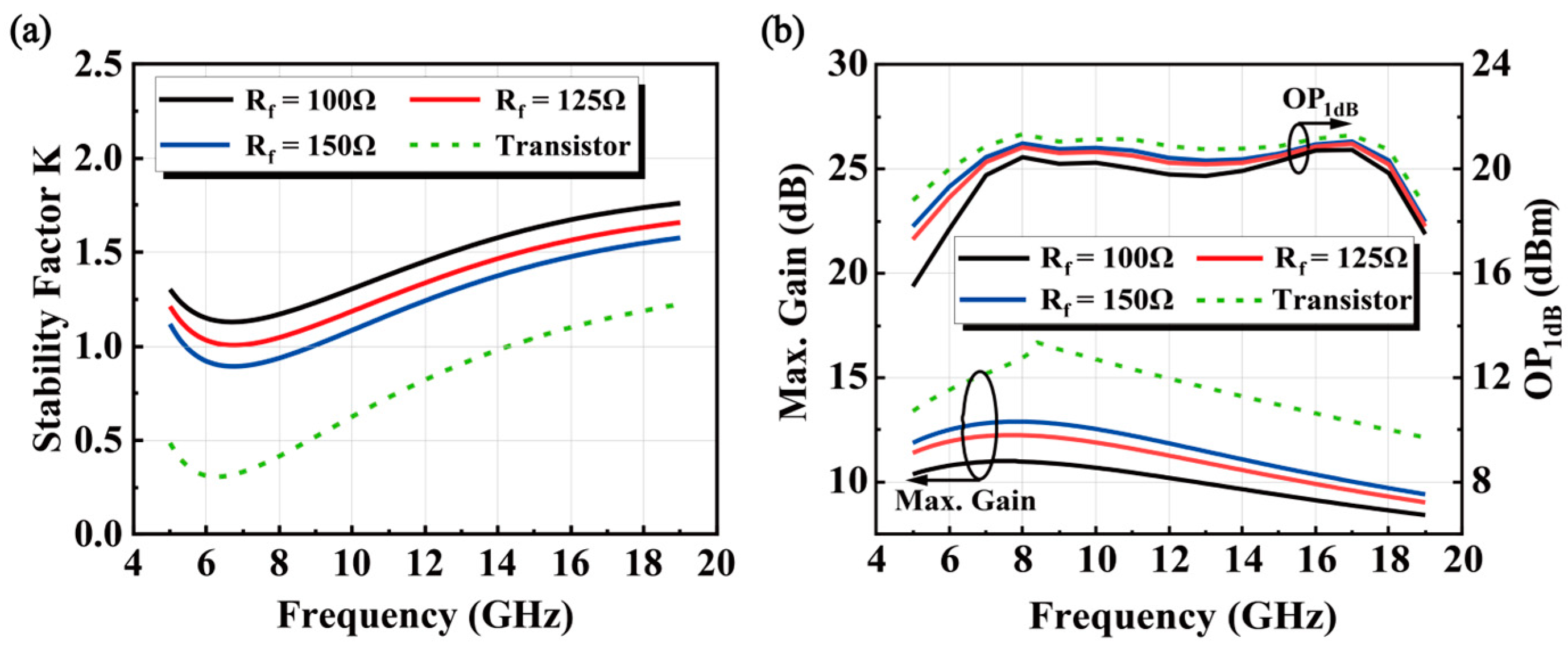A 6–18 GHz Low-Noise Amplifier with 19 dBm OP1dB and 2.6 ± 0.3 dB NF in 0.15 μm GaAs Process
Abstract
1. Introduction
2. LNA Circuit Design
2.1. Topology of the LNA
2.2. Resistive Feedback Technique
3. Results and Discussion
4. Conclusions
Author Contributions
Funding
Data Availability Statement
Conflicts of Interest
References
- Shan, L.Q.; Hu, Y.T.; Zhang, F.H.; Chen, M. Resource Allocation for Multicarrier Communication in the Finite Blocklength Regime. IEEE Wirel. Commun. Lett. 2023, 12, 1771–1775. [Google Scholar] [CrossRef]
- Nikandish, G.; Yousefi, A.; Kalantari, M. A Broadband Multistage LNA With Bandwidth and Linearity Enhancement. IEEE Microw. Wirel. Compon. Lett. 2016, 26, 834–836. [Google Scholar] [CrossRef]
- Jiang, Y.; Su, G.-D.; Sun, D.; Huang, Y.; Lin, Z.; Liu, J. GaAs based MMIC LNA for X-band Applications. In Proceedings of the 2022 IEEE MTT-S International Microwave Workshop Series on Advanced Materials and Processes for RF and THz Applications (IMWS-AMP), Guangzhou, China, 12–14 December 2022; pp. 1–3. [Google Scholar]
- Mesgari, B.; Saeedi, S.; Jannesari, A. Cell Weighting and Gate Inductive Peaking Techniques for Wideband Noise Suppression in Distributed Amplifiers. IEEE Trans. Circuits Syst. I Regul. Pap. 2020, 67, 4507–4520. [Google Scholar] [CrossRef]
- Yan, X.; Luo, H.; Zhang, J.; Zhang, H.; Guo, Y. Design and Analysis of a Cascode Distributed LNA With Gain and Noise Improvement in 0.15-m GaAs pHEMT Technology. IEEE Trans. Circuits Syst. II Express Briefs 2022, 69, 4659–4663. [Google Scholar] [CrossRef]
- Li, N.; Feng, W.; Li, X. A CMOS 3-12-GHz Ultrawideband Low Noise Amplifier by Dual-Resonance Network. IEEE Microw. Wirel. Compon. Lett. 2017, 27, 383–385. [Google Scholar] [CrossRef]
- Wang, Z.; Chen, J.; Hou, D.; Zhou, P.; Chen, Z.; Wang, L.; Xu, X.; Hong, W. A 1-27 GHz SiGe Low Noise Amplifier With 27-dB Peak Gain and 2.85 ± 1.45 dB NF. IEEE Trans. Circuits Syst. II Express Briefs 2024, 71, 2629–2633. [Google Scholar] [CrossRef]
- Caddemi, A.; Cardillo, E.; Patanè, S.; Triolo, C. An Accurate Experimental Investigation of an Optical Sensing Microwave Amplifier. IEEE Sens. J. 2018, 18, 9214–9221. [Google Scholar] [CrossRef]
- Razavi, B. RF Microelectronics, 2nd ed.; Prentice-Hall: Englewood Cliffs, NJ, USA, 2011. [Google Scholar]
- Wang, L.; Cheng, Y.J. A 2-20-GHz Ultrawideband High-Gain Low-Noise Amplifier With Enhanced Stability. IEEE Microw. Wirel. Compon. Lett. 2024, 34, 415–418. [Google Scholar] [CrossRef]
- Li, J.X.; Yuan, Y.; Zeng, J.L.; He, D.; Yu, Z.J. A Broadband LNA With Multiple Bandwidth Enhancement Techniques. IEEE Microw. Wirel. Technol. Lett. 2023, 33, 551–554. [Google Scholar] [CrossRef]
- Cheng, X.; Zhang, L.; Chen, F.-J.; Deng, X. A broadband GaAs pHEMT low noise driving amplifier with current reuse and self-biasing technique. Analog. Integr. Circuits Signal Process. 2019, 99, 191–198. [Google Scholar] [CrossRef]
- Yang, Z.; Wang, K.S.; Fan, Y.H.; Yan, Y.P.; Liang, X.X. Design of a GaAs-Based Ka-Band Low Noise Amplifier MMIC with Gain Flatness Enhancement. Electronics 2023, 12, 2325. [Google Scholar] [CrossRef]
- Chen, Y.M.; Wang, Y.S.; Chiong, C.C.; Wang, H. A 21.5-50 GHz Low Noise Amplifier in 0.15-μm GaAs pHEMT Process for Radio Astronomical Receiver System. In Proceedings of the IEEE Asia-Pacific Microwave Conference (APMC), Electr Network, Brisbane, QLD, Australia, 28 November–1 December 2021; pp. 7–9. [Google Scholar]
- Babenko, A.A.; Lasser, G.; Popovic, Z. 0.01-22-GHz Feedback-Stabilized Single-Supply GaAs Cascode Distributed Amplifiers. IEEE Microw. Wirel. Compon. Lett. 2021, 31, 1291–1294. [Google Scholar] [CrossRef]




| Reference | Technique | Freq. (GHz) | Gain (dB) | NF (dB) | OP1dB (dBm) | PDC (mW) | Area (mm2) | FOM |
|---|---|---|---|---|---|---|---|---|
| [5] | 0.15-μm GaAs | 2–42 | 14.1 | 3 | 10 | 129 | 1.53 | 21.86 |
| [11] | 0.15-µm GaAs | 0.5–24 | 24.7 | 1.7-2.8 | 10 | 212 | 1.47 | 27.38 |
| [12] | 0.15-μm GaAs | 17–28 | 17 | 2.2 | 6 | 30 | 1.5 | 20.66 |
| [13] | 0.15-μm GaAs | 32–40 | 21.5 | 2.2 | 10 | 56 | 1.35 | 25.59 |
| [14] | 0.15-μm GaAs | 22.5–34 | 22.5 | 3–4.5 | −2.5 | 36 | 2.5 | 1.44 |
| [15] | 0.15-μm GaAs | 0.01–22 | 23 | NA | 21 | NA | 3.75 | NA |
| This Work | 0.15-μm GaAs | 6–18 | 25 | 2.3–2.9 | 21 | 720 | 2.16 | 35.52 |
Disclaimer/Publisher’s Note: The statements, opinions and data contained in all publications are solely those of the individual author(s) and contributor(s) and not of MDPI and/or the editor(s). MDPI and/or the editor(s) disclaim responsibility for any injury to people or property resulting from any ideas, methods, instructions or products referred to in the content. |
© 2025 by the authors. Licensee MDPI, Basel, Switzerland. This article is an open access article distributed under the terms and conditions of the Creative Commons Attribution (CC BY) license (https://creativecommons.org/licenses/by/4.0/).
Share and Cite
Wang, X.; Men, T.; Cheng, B. A 6–18 GHz Low-Noise Amplifier with 19 dBm OP1dB and 2.6 ± 0.3 dB NF in 0.15 μm GaAs Process. Electronics 2025, 14, 1600. https://doi.org/10.3390/electronics14081600
Wang X, Men T, Cheng B. A 6–18 GHz Low-Noise Amplifier with 19 dBm OP1dB and 2.6 ± 0.3 dB NF in 0.15 μm GaAs Process. Electronics. 2025; 14(8):1600. https://doi.org/10.3390/electronics14081600
Chicago/Turabian StyleWang, Xiyang, Tao Men, and Buwen Cheng. 2025. "A 6–18 GHz Low-Noise Amplifier with 19 dBm OP1dB and 2.6 ± 0.3 dB NF in 0.15 μm GaAs Process" Electronics 14, no. 8: 1600. https://doi.org/10.3390/electronics14081600
APA StyleWang, X., Men, T., & Cheng, B. (2025). A 6–18 GHz Low-Noise Amplifier with 19 dBm OP1dB and 2.6 ± 0.3 dB NF in 0.15 μm GaAs Process. Electronics, 14(8), 1600. https://doi.org/10.3390/electronics14081600






